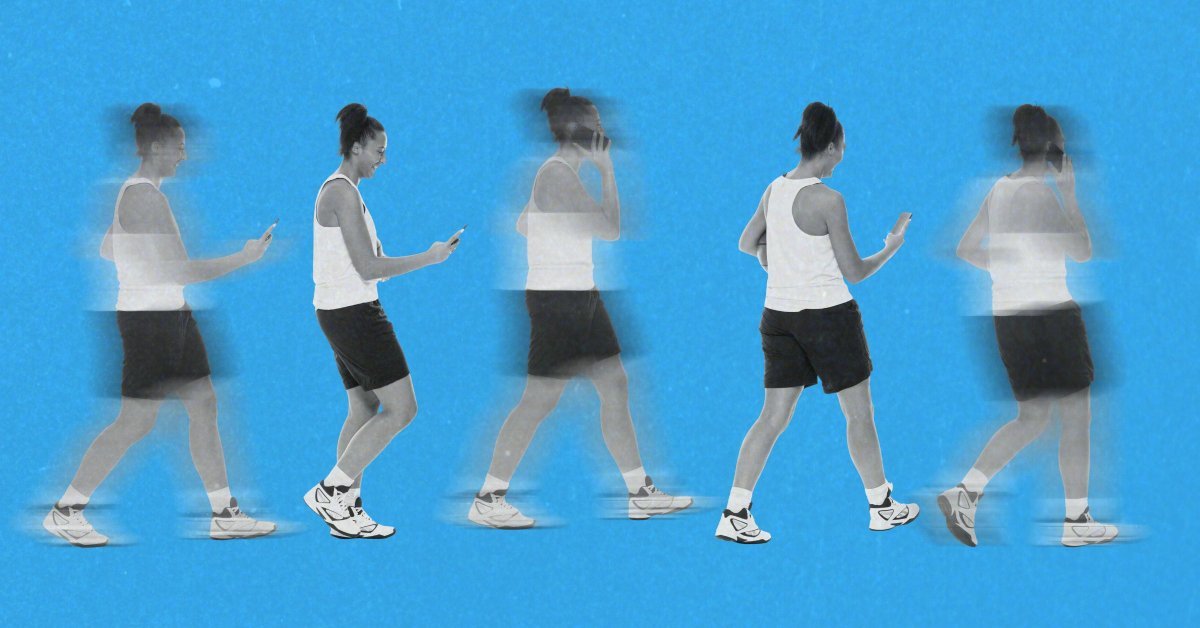“Japanese walking” isn’t new, but the workout recently gained legs on TikTok: People credit it with making their walking routines more exciting and leading to an array of benefits, from weight loss to better heart health.
While its name is derived from research conducted in Japan, this style of workout—known as interval walking—is popular around the world, and for good reason. It involves walking at a high intensity level for three minutes, followed by three minutes at a lower intensity, on repeat for at least 30 minutes, four times a week.
“We know that exercise matters, and we know that intensity matters,” says Laura Richardson, an exercise physiologist and clinical associate professor of kinesiology at the University of Michigan. “I think it’s caught on because it’s so sustainable—it’s short, it’s doable, you don’t have to be in a gym, and there are lots of benefits to walking.”
We asked experts to break down exactly why Japanese walking is so effective and how to get started.
The science behind interval walking
Interval training—or alternating between short bursts of high-intensity exercise, followed by lower intensity rest and recovery—has been around for more than 100 years. You can apply it to all kinds of fitness regimens, including walking, biking, running, and strength training. “It’s getting your heart rate up and then bringing it back down,” Richardson says. When you work out at a high intensity, you increase blood flow to your body’s muscles and make your heart beat faster. “That’s where we get health benefits,” she adds. “The adaptations begin happening at higher levels of intensity.”
Over time, interval training leads to increased cardiorespiratory fitness, which means your body can better consume oxygen because your heart and lungs are stronger. And you don’t have to spend hours at the gym to achieve it: By adding intensity to your workouts, you get more bang for your buck from a time perspective, says Rashelle Hoffman, a gait and walking expert in the physical therapy department at Creighton University in Omaha. Consider the American College of Sports Medicine’s physical activity guidelines: All healthy adults should get moderate intensity aerobic activity for at least 30 minutes five days a week, or vigorous activity for a minimum of 20 minutes three times per week. “Clearly, you’re seeing greater benefits with less time with vigorous activity,” she says. “We’re stressing our body out more, and it’s responding more readily to that.”
Read More: Backward Walking Is the Best Workout You’re Not Doing
There’s a psychological appeal, too. Interval walking enables you to feel like you’re competing against yourself, Richardson says, as you get faster and ratchet up your intensity level. “I always say that people like numbers,” she says. They give walkers a tangible goal, which can propel their desire to work out.
Emily Mendez, who lives in Indianapolis, took up Japanese walking a few years ago because she tends to get bored walking at the same pace. The intervals give her something to focus on, she says, and she likes the sense of achievement she gets from short, powerful spurts of activity. “It’s like an accomplishment when you do the quicker walks,” she says. “I do those and push myself, and then the slower walks for recovery are like a reward. It makes it more interesting, less boring, and more motivating.”
The benefits of Japanese walking
In one of the leading studies on interval walking, Shizue Masuki and her colleagues instructed 246 middle-age and older adults to walk at a high intensity for 30 minutes a day, more than four times a week, for five months. No one completed the program—they complained that it was too boring and difficult, says Masuki, a professor at Shinshu University Graduate School of Medicine in Japan. That inspired the researchers to test interval walking instead.
This time, the participants actually did it, and the results were impressive. People who followed an interval walking program for five months experienced greater increases in leg strength, thigh muscle strength, and overall physical fitness, as well as a greater reduction in blood pressure, than those who only walked at a moderate pace. Additional research with more than 700 people found that interval walking improves symptoms of lifestyle-related and age-related diseases, such as changes in cognitive function, depression, and sleep quality. Plus, the technique leads to an increase in healthy HDL cholesterol levels, improved triglyceride levels, and reduced abdominal visceral fat.
More generally, research suggests that walking—which is lower impact than activities like running—contributes to bone and muscle health, reduces the risk of chronic diseases, and enhances mental wellbeing. It’s often an ideal choice for people who are older or overweight, Hoffman says, as well as those newly dipping their toes into an exercise routine. “The beauty of walking is that most people know how to do it,” she says. “There’s not a learning curve, and you don’t really need to have equipment.”
What counts as high intensity, anyway?
In Masuki’s study, participants logged three minutes of walking at 70% of their peak aerobic capacity, or VO2 max—which measures the maximum amount of oxygen your body can utilize during intense exercise—followed by three minutes at 40% of their peak aerobic capacity. While a smartwatch can provide you with this data, there’s an easier way to track your intensity.
Read More: Why Walking Isn’t Enough When It Comes to Exercise
Richardson calls it the talk test: When you’re working at about 70% of your aerobic capacity, you’ll be breathing heavily and able to feel your heart racing, but you’ll still be able to carry on a conversation. “It’s a little bit uncomfortable, but you can still talk,” she says. If you were closer to working at 100% of your capacity, on the other hand—an extreme level that experts advise against, since your body can’t get enough oxygen to fuel muscles and you’ll quickly feel drained—you would not be able to speak.
How to start interval walking
Ready to give Japanese walking a spin? Experts suggest these tips.
Slowly titrate up
If three full minutes of high-intensity walking feels daunting, ease in: You could start out by picking up your pace for one minute, followed by a three-minute recovery session, Hoffman suggests. “You won’t see the benefits necessarily at those lower levels, but you’ll be training your body,” she says.
You don’t even have to aim for a 30-minute workout. Since learning about Japanese walking on TikTok a couple months ago, Yvette Hill has been doing it during downtime, like when she’s waiting in parking lots to pick up her kids from various activities. Sometimes she ramps up her intensity until she reaches one corner of the lot, then slows down until she reaches the other, tweaking the program to fit her needs. “If you’re busy, this is a great way to fit in exercise,” she says. “It’s so easy and less intimidating than jumping into the gym.”
Adopt the right stance
When you increase your pace and shift into a high-intensity interval, it’s important to pay attention to your posture. “Get your spine up, get your chest up, and really think about swinging your arms,” Richardson says. That helps engage more of your body, while adding power to your steps.
Find a timer system that works for you
Many fitness trackers, including the Apple Watch, have a built-in feature that allows you to set up your intervals in advance. That way, your device will alert you when it’s time to switch gears, Hoffman says, and you don’t have to fiddle with a stopwatch.
Read More: Are Walking Pads Worth It?
Another option: Time each interval to a favorite song. “Most songs are about three minutes long,” Richardson says. “That’s a good way of timing your exercise.”
Add some accessories
If you struggle with balance issues and want to make sure you’re safe, experiment with walking poles, Richardson suggests. “They can give you an extra bit of stability,” she says. “If someone’s a little hesitant—maybe an older or deconditioned person—using a hiking stick or trekking poles can give you an extra set of so-called legs.”
Be mindful of different types of terrain
One of the reasons walking is so accessible is that you can do it anywhere. That said, high-intensity exercise will feel different depending if you’re walking on a treadmill, nature trail, hilly roads, or the beach. “Your heart rate’s going to respond differently to all those different terrains,” Richardson says. Pay attention to what works best for you—you might find, for example, that you love the built-in challenge of walking on the sand or crave quiet moments in the park.
Make it even more challenging
Like any other fitness program, there are ways to adjust interval walking to fit your needs. You could wear weights on your arms or even carry small dumbbells to get a better upper body workout, Hoffman suggests. Or switch things up and do squats or lunges for one of your high-intensity intervals. “This idea of intervals could be applied to different targeted areas of your body,” she says. “It doesn’t have to be just walking.”




